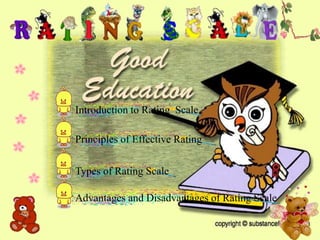
Rating Scales.ppt
- 1. Introduction to Rating Scale Principles of Effective Rating Types of Rating Scale Advantages and Disadvantages of Rating Scale
- 2. It is the second form of assessment. It offers ways to attach quality to various elements of the process or product. Performances is not only applicable for Science subjects, MAPE or PEHM, HELE or THE subjects. Process or product refers to student's performance or the behaviors shown while doing the product itself. Rating scales consists of a set of characteristics or qualities to be judged and some type of scale for indicating the degree to which each attribute is present.
- 3. Characteristics should be educationally significant. it must be in harmony with the desired learning outcomes of the school. In constructing a rating scale the best guide in determining what characteristics is most significant is the list of learning outcomes. Do not assign characteristics that are not related to the learning outcomes. Characteristics should be directly observable. the characteristics should be limited to those that occur in a classroom situation so that they can be observed. They should also be visible to an observer like participating in class discussions and clear enunciation. Interest in opposite sex and feeling in inferiority is not an example of this.
- 4. Characteristics and points on the scale should be clearly defined. The use of general and vague characteristics should be avoided. Brief descriptions instead must be used for clarity of meaning and fuller understanding is obtained if each characteristics being rated. Raters should be instructed to omit ratings where they feel unqualified to judge. It is better to permit the rater to omit characteristics that are unable to judge. Some rating forms provide a place to check “unable to observe” for each characteristic. Others provide a space for comments after each characteristic, where it is possible either to justify the rating given or to note the reason for not making a rating.
- 5. Ratings from several observers should be combined, wherever possible. When possible, if there are several raters, the scores must be combined to provide a more reliable description of a pupil’s behavior. Limit the number of points in a scale. There is no advantage if we indicate several points in a rating scale like a seven – point scale. In areas permitting only crude judgments, only fewer scales positions are needed.
- 6. . Each characteristics is followed by a horizontal line. The rating is made by placing a check or “X” mark on the line.
- 7. . Directions: Indicate the degree to which this pupil contributes to class discussions by placing an “X” anywhere along the horizontal line under each item. 1. To what extent does the pupil participate in discussion? 2. To what extent are the comments related to the topic under discussion? Never Seldom Occasionally Always Frequently Never Seldom Occasionally Always Frequently
- 8. . The rater checks or circles a number to indicate the degree to which a characteristic is present. Each of a series of numbers is given a verbal description.
- 9. Directions: Indicate the degree to which this pupil contributes to class discussion by encircling the appropriate number. The numbers represent the following values: 5 – Outstanding, 4 – Above Average, 3 – Average, 2 – Below Average and 1 – Unsatisfactory. 1. To what extent does the pupil participate in discussion? 2. To what extent are the comments related to the topic under discussion? .
- 10. It uses descriptive phrases to identify the points on a graphic scale. A descriptive phrase is placed beneath each designated point. A space for comments are also provided.
- 11. Directions: Make your ratings on each of the following characteristics by placing an “X” anywhere along the horizontal line, under each item. In the space for comments, include anything that helps clarify your rating. 1. To what extent does the pupil participate in discussions? Comment: Never participates; quiet and passive Participates as much as other group members Participates more than any other group member
- 12. Directions: Make your ratings on each of the following characteristics by placing an “X” anywhere along the horizontal line, under each item. In the space for comments, include anything that helps clarify your rating 2. To what extent are the comments related to the topic under discussion? Comment: Comments ramble, distract from topic Comments usually pertinent, occasionally wanders from topic Comments are always related to topic
- 13. Give more insights on how well/often the child performed each task. Evaluate performance that not readily measure by testing. Structured and standardized. Easily compared. Encourages equality in treatment. Impose standard measure of performance. Easy to use and understand. Economical in cost and time. Reduce rater bias and subjectivity. Click me to view the next slide…
- 14. Ambiguity – different raters interpret rating terms in different ways Leniency – rate or evaluate favorably those whom they know well higher than they should Central Tendency – reluctance to give extreme ratings Halo – Look at the overall total performance Logical – give similar ratings to traits that seem to be logically related in the mind of the rater Contrast – evaluate in a direction opposite of themselves. “Considering that I am a very well – organized individual, no one can be well – organized as I am. Proximity - nearness in time or location on a rating form. Traits to be rated on the same page tend to correlate higher than if they are rated on different pages